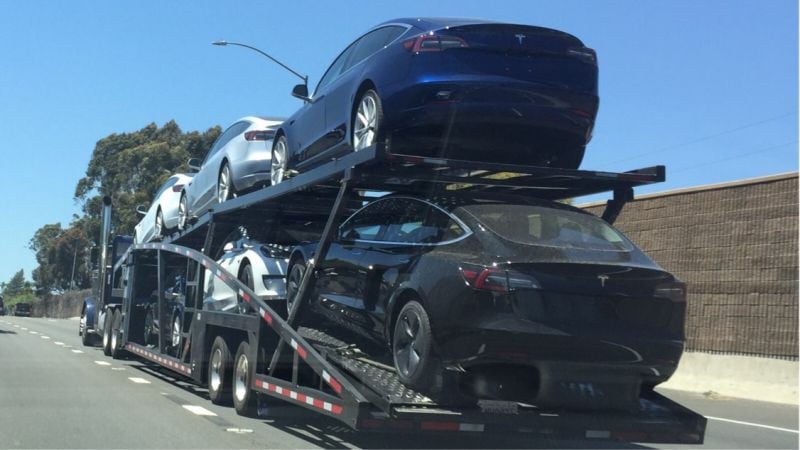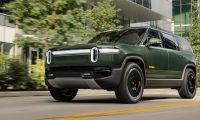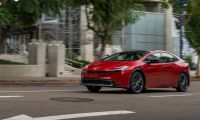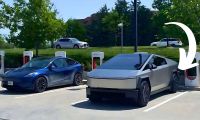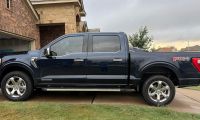As Tesla Corporation is steady as she goes with churning out approximately 4,000 Model 3’s per week at last count, a new problem has presented itself for the electric car and energy company. With “Production Hell” seemingly behind them, for now, they seem to haphazardly paid a visit to “Logistics Hell,” “Production Hell’s” next door neighbor, to invite them in. So dealing with problems of scale, Tesla goes from the extreme of not making enough cars, to having too many around when they’re fully assembled, that they are now not being delivered to customers on time. The last week of September becomes crucial for them, as that’s also the last week of the third quarter, where they’re expecting record profits. So the final push has left them short on transportation equipment to move inventory. And if they aren’t careful resolving this, this may lead to a serious bottleneck, between now and next quarter, the same kind of bottleneck last year with supply issues with the assembly process, that could cause them to cut or stop assembly if they run out of room:
- Tesla is upgrading/improving its logistics system. As a result it has a growing back inventory of too many Model 3’s that need customer delivery.
- This is probably caused by some combination of poor, unanticipated, or inadvertent planning, or lack of experience for a learning curve.
- This is Rush Week, where the final push is out to pull all the stops to make as many sales and deliveries possible.
- The trucking industry verifies there is no shortage of truck trailer car carriers in California, but you need to book in advance.
- Apparently with this not being done as the situation reaches crisis levels, Tesla went to the extreme of fabricating their own car carriers so they can catch up with shipping.
- As they sort this out, Tesla is pulling all the stops to maximize sales and deliveries before the quarter turns over.
- With programs like “Tesla Direct,” Tesla is dropping off cars at staging areas, delivery centers, and Tesla Stores. They’re even delivering cars to customers’ homes and offices.
- This is similar to the Tesla event a few weeks previously where they were selling manufactured non-ordered cars not made for the waitlist or custom ordered. As it was then, a customer can walk in this last week to buy a new Model 3 they didn’t intend to order or waitlist, and walk away with papers and keys to drive off in a new car off the rack.
- Sales are authorized to bring back free super charging for Models S, X, and Performance Model 3, and 1 year of free super charging for the other Model 3 variants. To take advantage of either, you must take delivery by the end of the month and have a present customer’s referral code.
- Tesla is asking present owners to “volunteer” to help them give new car owner orientation to customers picking up their cars so they can speed up the process.
- Still waiting customers are giving CEO Elon Musk the business on Twitter and he has apologized with a promise of a turn around coming soon.
- This with the backdrop of Musk walking away at the last minute from what sources say was a sweet settlement deal with the SEC over the Tweet-gate “Funding Secured” Scandal. He says he backed out on principle.
- As a result, the Security and Exchange Commission filed suit in federal court for corporation and investor fraud, alleging Musk lied when he said “funding secured,” and gave the $420 figure to impress his girlfriend after recently learning the number means marijuana.
Delivery Rush Week for Q3:
As the final week of September coincides with the end of the third quarter, Tesla suddenly finds itself in a race against time to deliver as many cars as it can pulling out all the stops, and doing what it has to do. During this time period which they call Rush Week, Tesla is doing all they can to enhance that crucial soon to come bottom line for the third quarter. This is a key quarter for Tesla, not only to prove that they’re getting their production issues behind them, but that they can be a profitable operation with the right production figures. Tesla is poised to have its most profitable quarter in its history. As Musk recently wrote in a company letter to employees, “We are about to have the most amazing quarter in our history, building and delivering more than twice as many cars as we did last quarter.” But with production issues out of the way, at least for now, the obstacles Tesla now faces are more about logistics than they are about production. In the one week rush to deliver as many cars as they can to help that bottom line for the quarter, Tesla has a new problem of not being able to deliver all these cars to customers, not just on time, but at all.
@elonmusk Leased a Model S for two years in 2016. Have a day one reservation for a M3 AWD. Placed order at end of June. Still don't have M3 AWD. Lease ends in one week! New customers getting M3 AWD before me? No help from Tesla. I helped keep the lights on at Tesla! Please help? pic.twitter.com/grMvFwJMdm
— Chris Barker (@ctbarker32) September 24, 2018
During the assembly process Tesla makes several examples of various variants in bundles, some to satisfy custom orders, the rest to have as available inventory to flip and make a quick buck. It doesn’t help for anticipating customers to see Tesla doing these programs to boost sales and get new owners into off the rack cars many never intended to buy, when waitlisters were on top of the waitlist and still haven’t received their cars. In a conversation on Twitter between Tesla CEO Elon Musk and several still waiting customers for their Model 3 delivery, Musk revealed that the company started building their own car carriers in order to prevent bottlenecks in the customer delivery process, that if not careful, that could jeopardize the assembly process, thus jeopardize the entire production line. With a record profitable quarter expected, Tesla seems to be holding the line at about 4,000 cars on average per week. But having newly assembled cars laying around the lots by the factory and at staging areas nearby or further, when even newer assembled cars could be stored there in their place, doesn’t help this logistics situation. So Tesla’s solution is if they can’t find the car carriers they need, they’ll make them for themselves.
Apologies, we’re upgrading our logistics system, but running into an extreme shortage of car carrier trailers. Started building our own car carriers this weekend to alleviate load.
— Elon Musk (@elonmusk) September 24, 2018
About the Car Carriers
Another reason why Tesla needs car carriers now is because they are a slave to a circumstance that presented itself in a unique situation they weren’t anticipating or prepared for, similar to the tent dynamic. Unlike the good relationships Tesla keeps with their worldwide suppliers for the parts for them to make cells around the lithium ion batteries and the pack themselves, Tesla doesn’t have that kind of relationship with trucking companies shipping their inventories, at least not yet, because they haven’t shipped these many cars ever. Our colleagues over at Jalopnik asked Guy Young, General Manager of the Auto Haulers Association of America if Elon was correct about there being a car carrier shortage. They conveyed his reply like this:
“Young did have a possible explanation about what may be going on with Tesla. Essentially, Young suggested that the issues may not be about an actual shortage of auto haulers, but a lack of planning on Tesla’s part. It’s possible, Young speculated, that Tesla had not taken the time to establish their relationships with auto haulers early enough, and are now finding themselves in a position where they’re unable to get car carriers to meet their desired timetables.”
It is unknown how many carriers Tesla needs and how many will be eventually built, in total. The prototype Semis were not mentioned if they will participate in this operation, and between their obligations on tour showing themselves to Tesla’s soon to be most valued commercial customers interested in buying them, and their steady jobs working the Gigafactory route shipping supplies and batteries to and from Fremont that’s part of their testing phase, it’s doubtful they will. Semis go into production as early as later next year 2019, probably early 2020.
Since Tesla is a motor vehicle manufacturer and parts maker, that puts them on a fast track and gives them lots of latitude as to what they can make and put on the road to make it considered roadworthy. They don’t need to have a Tesla rep wait on a long state DMV line to get one of their vehicles or an attached trailer equipment registered, same thing for DOT approval. All road equipment must have a bond or insurance, but in most states car makers have their own car manufacturer’s plates.
plenty of time to cover your puts before they go to zero $TSLAQ $TSLA pic.twitter.com/vOcuGyZtfw
— Jason Lewis (@cbotnyse) September 23, 2018
SEC Lawsuit
Rush Week and the car carrier crisis is the backdrop while negotiations between Musk and the Security and Exchange Commission were about to settle out of court with a deal considered quite favorable to Musk given the circumstances of the Tweet-gate “Funding Secured” Scandal.
Although Musk renegade on the deal initially he finally decided to accept losing his chairmanship with the board. He remains as CEO. Two additional independent board members will be appointed and both the company and Musk must each pay a $20 million USD fine, $40 million total. That represents a little more than .1% of Mr. Musk’s total personal wealth. In a sworn deposition, Musk told investigators he wanted to impress his girlfriend with the buyout 420 figure. Funding was not secured according to SEC investigators. With the initial reneg the SEC filed suit in federal court. Ultimately everyone settled.
It seems that the Tesla way is the high stakes way of doing things, and that’s the paradox of the Land of Elon Musk on Teslaworld. In the meantime there’s a mad rush to the door at Tesla and they seem to have a recruitment and retention problem. The irony is that it seems everyone cannot contemplate Tesla without Musk, to remember there was a time Apple was without Steve Jobs the first time he left the company after the board of directors launched him, and the second time for eternity, when Tim Cook took the helm to take Apple on a trajectory that some say, just wouldn’t have been the same or perhaps as successful if Jobs was still there. A similar theory may be applied to Tesla. Unwillingly . . .
What’s your take on the car carrier crisis while the SEC takes Musk and Tesla to court? Let us know below!



